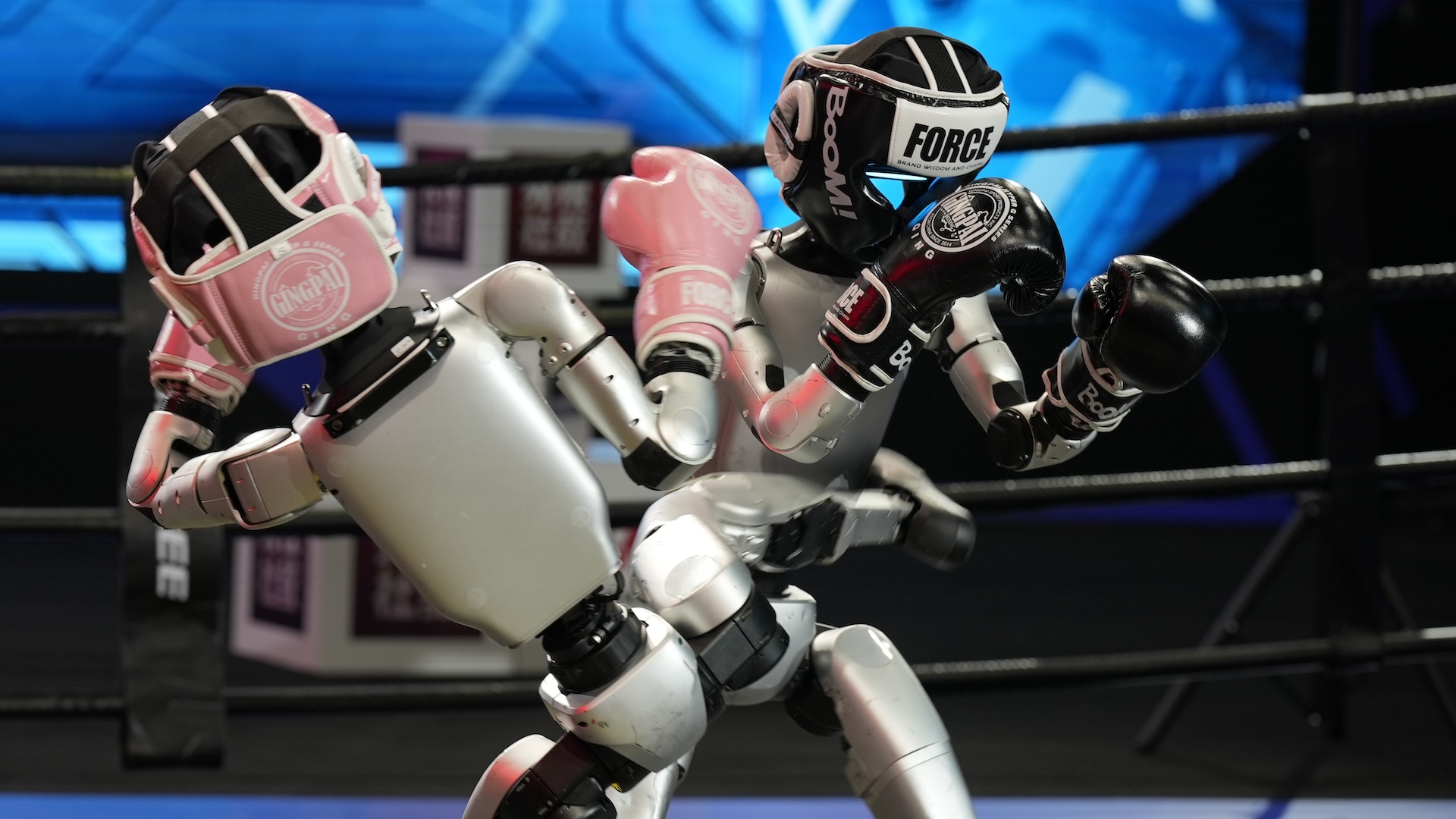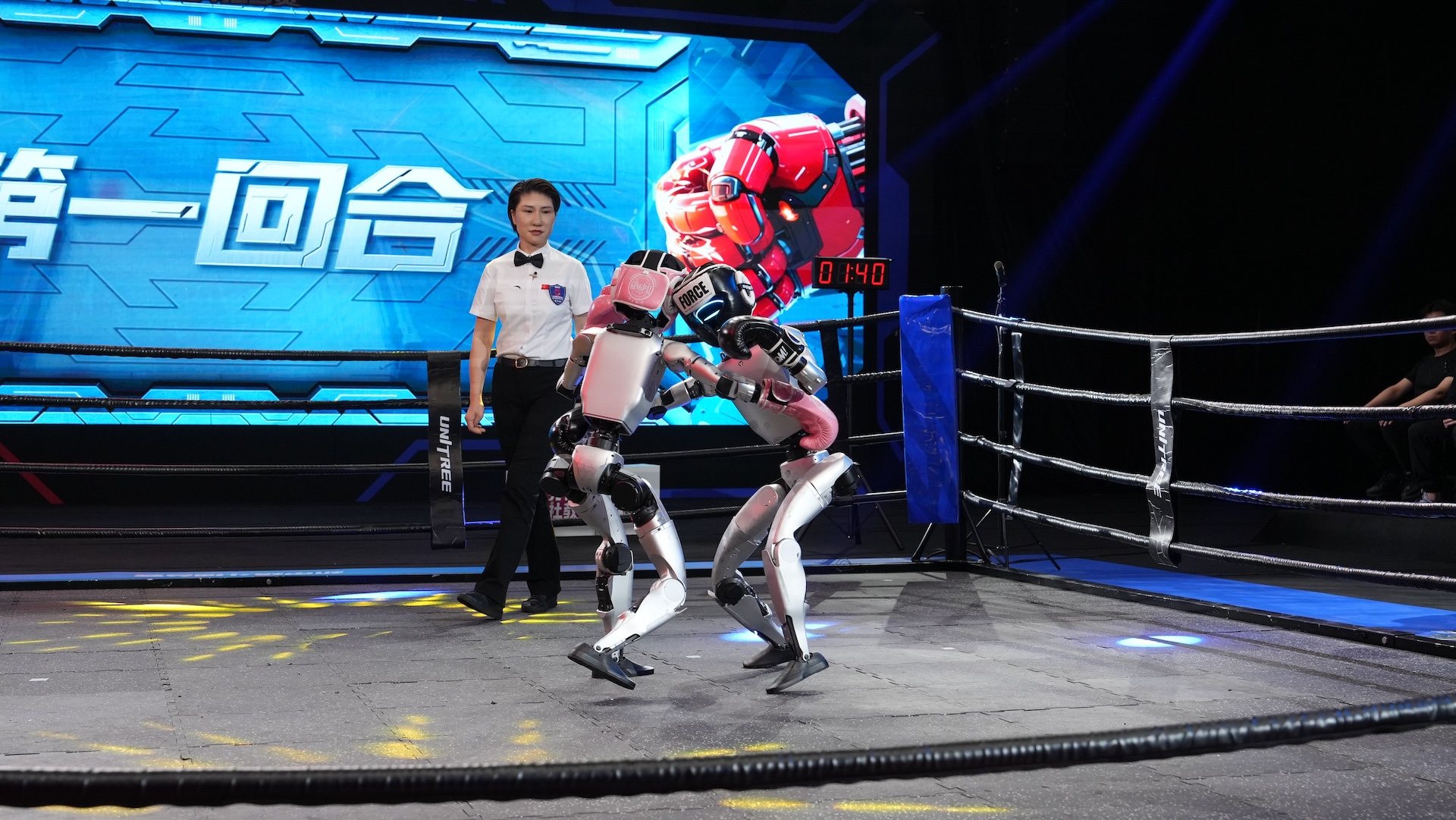China pits rival humanoids against each other in world's first 'robot boxing tournament'
Unitree's combat robots can punch and kick while keeping their balance, but they are controlled by humans — for now.

Lifelike humanoid robots have competed in the world's first humanoid robot combat competition, with four Chinese teams pitting advanced fighting robots against each other.
The China Media Group (CMG) "World Robot Tournament — Mecha Combat Arena'" competition was held in Hangzhou, China, May 25 and broadcast nationwide on China's state-run CCTV-10 science channel. During the tournament, viewers watched Unitree's G1 humanoid robots spar for the first time — throwing punches and kicks and dodging incoming attacks.
Four teams — black, pink, green and red — took part in the competition, with each controlling a robot using unique tactics. For example, the green team, led by electrical engineer Hu Yunqian (nicknamed "Power Core Guardian") used a "steady pressure, inch-by-inch advance" approach to defeat opponent robots.
Throughout the fight, the team chose to pilot the robot remotely using a game pad because this method had a lower latency — the lag between when a command is issued and when the robot responds — than other control modes, such as artificial intelligence (AI) voice control and motion sensing, Unitree representatives explained.
In contrast, the pink team leader, Jiao Tianqi (nicknamed "The Silk Artisan"), ran a "muscle memory precision" strategy focused on leveraging reflexes and overwhelming opponents with sheer attack speed.
Metalweight boxing
The G1 humanoid robot is capable of moving across numerous axes and with high precision, Unitree representatives said in a statement.
In addition to throwing punches using its shoulder joints, it can swing its hips and knees to kick opponents. Unitree representatives also stated that the G1's arms have seven degrees of freedom — more than other robots and the same as a human arm. These break down into three possible rotations of the shoulder and wrist, respectively, as well as the opening and closing motion of the elbow.
Get the world’s most fascinating discoveries delivered straight to your inbox.
Humanoid robots tend to need special algorithms and sensors to keep them from toppling over when carrying out complex movements. Whereas most humans learn to balance from a young age, robots need precise instructions to maintain their balance when performing tasks.



The G1 highlights the leaps researchers have made in getting robots to not only punch without falling over but also stay upright while kicking and dodging attacks. In combat, the robots experienced intense periods of physical strain, which they were engineered to withstand.
Unitree prepared the G1 to balance through these fights using AI reinforcement training, in which optimal behaviors are learned through exposure to massive amounts of data. The resulting algorithm was used in tandem with real-time balance sensors to keep the G1 upright with or without human control.
To keep the robot stable in combat situations, Unitree ran additional rounds of training in which the robot was hit from different angles and made to stay upright. They also equipped it with specific learned movements that helped it to balance, such as lowering its center of gravity through its legs or swinging its arms to stop itself from falling over.
Unitree stated that in future tournaments, it will deploy a robot with a more capable motion-sensing control system, for more "immersion" in combat.
Rory Bathgate is a freelance writer for Live Science and Features and Multimedia Editor at ITPro, overseeing all in-depth content and case studies. Outside of his work for ITPro, Rory is keenly interested in how the tech world intersects with our fight against climate change. This encompasses a focus on the energy transition, particularly renewable energy generation and grid storage as well as advances in electric vehicles and the rapid growth of the electrification market. In his free time, Rory enjoys photography, video editing and science fiction. He joined ITPro in 2022 as a graduate, after completing an MA (Hons) in Eighteenth-Century Studies at King’s College London. You can contact Rory at rory.bathgate@futurenet.com.
You must confirm your public display name before commenting
Please logout and then login again, you will then be prompted to enter your display name.



